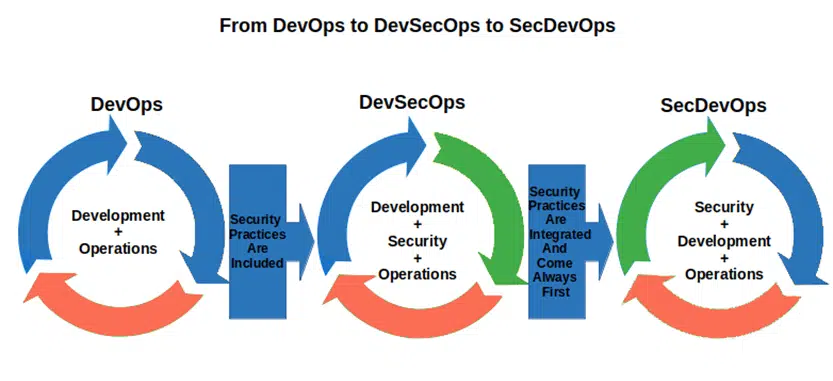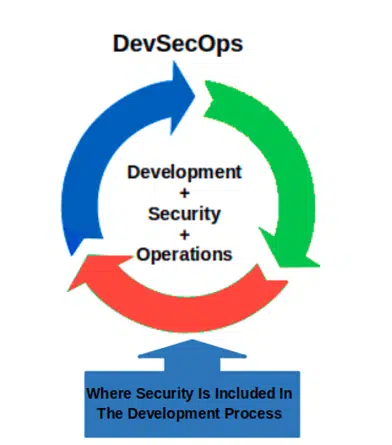SecDevOps vs DevSecOps: What’s the Difference?
Discover how a small change in word order can make a difference to your organization’s security strategy in software development by enabling you to deliver secure, high-quality software faster
With the number of security attacks skyrocketing and software being released more frequently, secdevops and devsecops have become popular terms within IT organizations looking to incorporate security into their devops processes.
But if you look at the two terms side by side — secdevops vs devsecops (or devsecops vs secdevops, if you prefer) — what do they really mean? Are they only two slightly different ways to call the same process or is there something more? And where does security fit in?
These are some of the questions that we’re going to answer in this article. You’ll discover the difference between secdevops vs devsecops, their key characteristics and, above all, their different approaches to security. This will enable you to identify the best development model for your organization to quickly deliver secure software to your customers.
SecDevOps vs DevSecOps: The Differences Are More Than Just Semantics
Once upon a time, there was a process known as devops. This was a magical method through which operations and developer teams worked together to release as often and quickly as possible, leveraging the power of automation and breaking silos. But there was one big problem: security, one of the most critical parts to every organization’s survival, was not included in the process. It was often cast aside in the name of usability and faster release timelines.
The solution to this issue came to light a few years later through the transition from devops to devsecops first and, more recently, to secdevops.

Devsecops is the most commonly used term to indicate that security is integrated into the software development process lifecycle (SDLC). For fun, we ran a search on Google and the difference in search results were remarkable:


However, even if secdevops and devsecops are often used interchangeably and look similar, if you really go into details, you’ll find that there are some fundamental differences between the two in the way security is approached.
| DevOpsSec | DevSecOps | |
|---|---|---|
| First Priority | Development | Security |
| Goal | To deliver software quickly and promote secure coding practices by implementing them from the planning and design stages throughout the SDLC. | To deliver secure software quickly by making security part of your development and operation teams’ daily routines. |
| Security Approach | Security must be integrated into every step of the SDLC. | Security must be integrated and come first into every step of the SDLC. |
| Collaboration | Development and security teams’ processes are visible and transparent. | Security and development teams work closely together and are in constant communication. |
| Testing | First, the quality assurance team does the functionality testing, then the security team does the testing for security vulnerabilities. | The quality assurance team and security team work together to test the application (rather than one team handing off to the other). |
| Vulnerabilities Fix | After testing, the identified vulnerabilities are sent back to the developers to make any necessary code changes. Many iterations may be needed to deliver a secure product. | The most critical flaws are fixed before moving to the next step of the SDLC. Others are prioritized and integrated into the workflow. |
You can read more about the comparison of devsecops vs secdevops in our previous article: What is Secure DevOps? Secure DevOps Explained. Now, let’s have a look into more details into the key attributes of secdevops and devsecops.
How SecDevOps Differs From DevSecOps and DevOpsSec
In many cases, people often use the terms secdevops, devsecops and devopssec interchangeably. Even if, at a first glance, the three terms look very similar and they do share the same goal, each is a slightly different approach.
SecDevOps: Where Security Really Comes First
The word’s sequence says it all: first comes security (sec), then development (dev), then operations (ops). With secdevops, security is integrated in each stage of the SDLC from the very beginning, and vulnerabilities are addressed “on the go” thanks to automation. As a result:
- The overall quality and security of the final product is higher,
- New versions and features are deployed much faster,
- Customer satisfactions goes up, and
- Your organization’s reputation also improves.

This sounds great, right? But are there really no drawbacks? What about costs? This is what we’re going to see next.
A Look at the Advantages and Disadvantages of SecDevOps
There are numerous advantages to implementing secdevops. However, like all changes, transitioning from devops to secdevops comes with a cost. Is it worth it? Let’s find out!
| Advantages of SecDevOps | Disadvantages of SecDevOps |
|---|---|
| Developers, security and operations work together towards a common goal. | Extra time and money will have to be invested to train all team members on secure best practices and tools. |
| Security policies, coding standards, best practices and guidelines are agreed upon at the beginning of the planning phase and followed throughout the SDLC process. | Developers will need the tools and the knowledge to implement security in an efficient way. Again, this will take time and money. |
| Repeated processes are automated where possible, saving time to dedicate to other essential tasks. | Implementing the process will require a switch of mentality and culture that could meet some resistance at the beginning. |
| Applications are monitored throughout the SDLC, facilitating corrections, thereby increasing the quality of the software. | Legacy applications are nearly impossible to update or modify without disrupting the process. |
| Codes are continuously checked for errors and vulnerabilities, improving application stability and reducing the number of fixes needed at the end of the pipeline. | |
| Every single code change is tracked and follows the agreed deployment procedures. | |
| Focusing on security from the very beginning helps you to decrease vulnerabilities, errors, and noncompliance-related issues — all of which can result in significant fines, penalties, and lawsuits. |
As you can see, despite a few drawbacks, it’s clear that secdevops brings significant advantages to organizations striving for excellence and looking to put security at the core of their business. Some challenges can be addressed, as highlighted in our previous article answers the question: What Is Secure DevOps? But what if you really can’t afford it? Can devsecops be a valid alternative?
DevSecOps: Where Security is Built Into the Development Process
Once again, if we have a look at the sequence of the words — development (dev), security (sec) and operations (ops) — it’s easy to understand that the main priority is given to the development process. This doesn’t mean that security doesn’t play a role or that it’s forgotten; it’s just approached in a different way, as already described in the table at the beginning of this article.

The goal of devsecops is to integrate security best practices (including testing) throughout the SDLC via automation. However, this doesn’t always happen. Usually, security resources are limited and integration is done at the last minute. Developers who are already under pressure to deliver projects on time and within budgets, end up with a list of vulnerabilities to fix right before deployment. As a result, delivering a great and secure product becomes much more difficult.
Despite these issues, devsecops has some interesting advantages that are definitely worth exploring.
DevSecOps: Advantages and Disadvantages
A study published by Verified Market Research shows that the global devsecops market could reach $17.16 billion by 2027. (Note: keep in mind that some people use devsecops and secdevops interchangeably, so it’s possible that secdevops was included in that calculation as well.) This demonstrates that devsecops is pretty popular among IT organizations, regardless of some restraining factors like the ones listed in the table below.
| Advantages of DevSecOps | Disadvantages of DevSecOps |
|---|---|
| Developers, security, and operations teams work together toward a common goal. | A lack of skilled security professionals can lead to a delayed release into production or to insecure software. |
| Security testing is integrated into the development testing, enabling the teams to identify security flaws before release. | Security policies and guidelines are only defined and followed before the security testing processes take place. |
| Security and development processes are transparent. | Security vulnerabilities are fixed without prioritization and at the best of the developers’ knowledge due to their lack of security skills. |
| Testing tools are integrated into the pipeline, contributing to an agile development process. | |
| Legacy applications can still be modified without impacting the process. |
In short, although devsecops isn’t perfect; it doesn’t prioritize security in the same way. However, when implemented properly, it’s still a big step forward in the right direction over traditional devops. Yes, in an ideal world, every organization would choose secdevops vs devsecops however, the reality is different: there are costs, resources and skills constraints to take into account, and it’s not always easy.
Final Thoughts on SecDevOps vs DevSecOps: What’s the Difference?
I hope this article answered the most important questions about the dissimilarities of secdevops vs devsecops. The big takeaway here is that even if the two terms are somewhat interchangeable, it should be clear that the differences between the two terms are not only a question of semantics. There are tangible differences between the two processes — from the tools and processes involved to the quality of the software produced.
While putting security first is usually the best solution in most cases, it’s important to remember that one size doesn’t always fit all. It will be up to you to decide which one of the two fits best to your organization. Don’t worry, though! This doesn’t mean that choosing devsecops vs secdevops will have a negative impact on the security of your products. As long as you ensure that security becomes part of the developers’ daily workflow and it’s not left at the end of the development lifecycle, you’ll enable your teams to deliver secure software faster to your customers.
Get rid of painful bottlenecks and make your application secure from the very beginning by embedding security processes into the development pipeline! Make the move from traditional devops to devsecops or secdevops now, and get your organization and your products secure by default!


